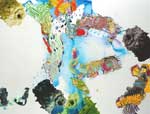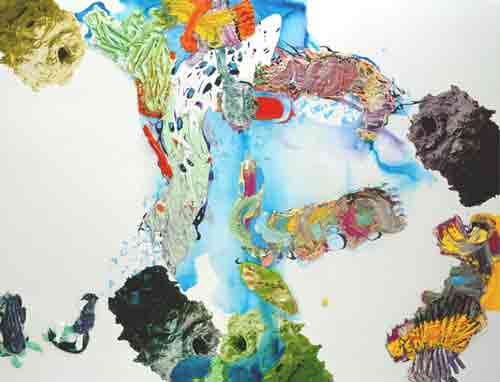
Caspian, 2001-2002.
Pia Fries: New Paintingsby Donald Goddard |
| Animals, including
humans, are presumably endowed with the ability to identify and distinguish an
extraordinary range of natural phenomena: the barks and leaves of trees, the
possibility of rain or snow, flowers, friends, enemies, the tracks and scents
of other animals. It's a matter of orientation, of establishing the coordinates
of life and death. The proliferation of information and knowledge has enabled
us humans to analyze our environment minutely and ad nauseum, though perhaps
less effectively than other species. Anyway, we have accounted for an awful lot. |

Caspian, 2001-2002. |
|
Pia Fries deliberately turns the process around, or at least understands that it can be turned around. What we see normally in the world is known to us in an almost infinite variety of ways, moment by moment. Inside the boundaries of art is another matter, or other matter. We are forced to look in other directions than the normal ones we need to survive, no matter how "realistic" or "naturalistic" the art. (Of course, we can dismiss the art before getting to the point of going off at right angles, or even backward.) Nature is suspended; we are focused within. It is not life and death, though it may be a matter of life and death. The curious power of Fries's work is that while it insists on its own space, on the defined boundaries of the rectangle, it also insists on being contiguous with the world around it, specifically as a microcosm of the whiteness of the gallery walls. What appears within the rectangle is utterly new, unidentifiable in the terms of our normal observations and consequent actions therefrom, and yet it calls upon exactly the same powers of observation. If nature is a single entity in a multitude of guises--earth, air, water, and fire--then paint is something similar. It is an infinitely malleable substance that Fries applies and shapes with an infinite variety of textures, gestures, and colors, using combs, scissors, and other ordinary implements, as well as brushes and knives. Colors are swirled, poked, molded, and even bound together in rhythmic sequences that appear to be, for instance, like the sequences and activities of a microscopic sample, a stream bed, or topography from the air. They are subject to logical thought and exploration. |
 Caspian, 2001-2002. Oil and screenprint on board, 78 3/4" x 102 3/8". |
|
The paintings are topographies, which even their made-up names--Belsize, Buckhurst, Caspian (not made-up), Vivelin, and Tellson--seem to indicate. Their terrain is whiteness, light that suffuses every color, an absence of darkness because these forms are constantly emerging out of the whiteness. They exist in light and are created not to defeat it. Thin washes, such as the river of blue running down (or up) the center of Caspian, are both evanescent and powerful, creating a kind of free-form undertow that pulls the heavier thicknesses of paint together. These thicknesses have a sense of hyperreality that pushes out into our space from pictorial space in very distinctive patterns that persist despite occasional interruption. And then they gather and form new vortexes, still remaining distinctive in their shapes, colors, and movements, and always intensified by light. Every form is changing, becoming, and at the same time definitive in form, like a flower or any detail of nature. What we end up exploring are layers of pre-existence, light seeming to be the first layer, which, with its very generalized physical reality, is part of every layer after its own. Screen-printed photographs of paint formations that Fries had made earlier are the second layer. In their single printed colors (the only images that have shadows as part of them), these shapes are like fossils, or documentary photos, and they loom as ghost images. They are also like dead stars or planets around which the rest of the universe continues to evolve, and their color registration marks (small circles with crosses) are left intact as a kind of topographical guide to what will come. Then there is the living paint, the three-dimensional globs and swipes and whirlpools that spread across the light and screen-printing (sometimes under the latter) in a kind of lyrical chain-reaction. Something from the core of nature, its brilliance and energy, is revealed. Donald Goddard © 2001 |
|
Tellson, 2001-2002. Oil and screenprint on board, 78 3/4" x 66 7/8". |
| The exhibition was held at CRG Gallery, 535 West 22d Street, New York, NY 10011. |
Art Reviews Listings - Next Review
Art Review - NYArtWorld.com - NYAW.com. All artwork is copyright of the respective owner or artist. All other material © Copyright 2015 New York Art World ®. All Rights Reserved.
NewYorkArtWorld ® - Back to Top